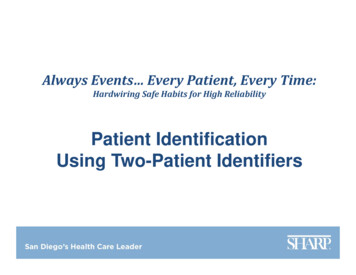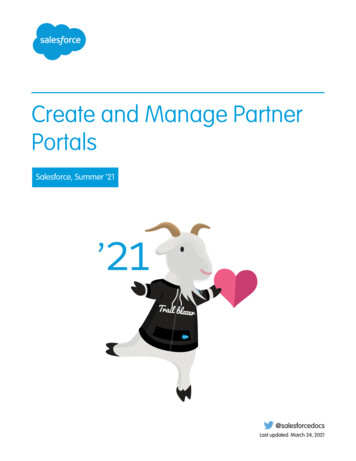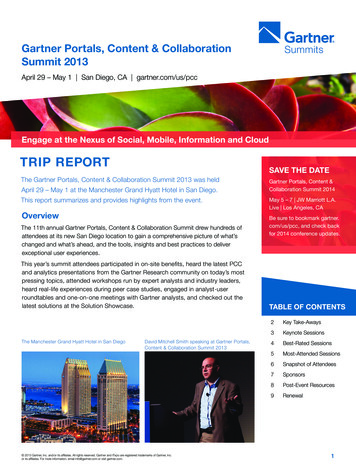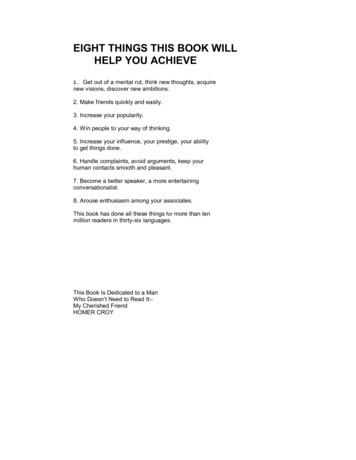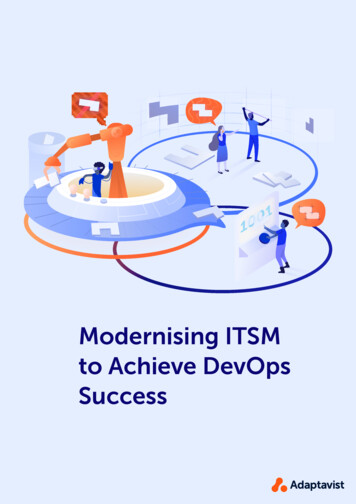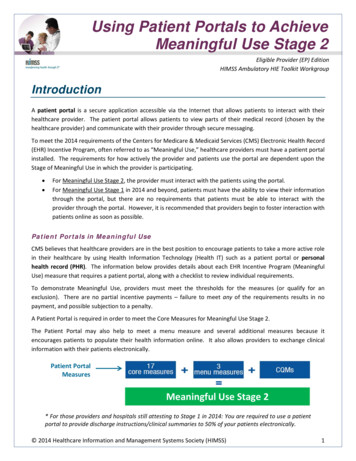
Transcription
Using Patient Portals to AchieveMeaningful Use Stage 2Eligible Provider (EP) EditionHIMSS Ambulatory HIE Toolkit WorkgroupIntroductionA patient portal is a secure application accessible via the Internet that allows patients to interact with theirhealthcare provider. The patient portal allows patients to view parts of their medical record (chosen by thehealthcare provider) and communicate with their provider through secure messaging.To meet the 2014 requirements of the Centers for Medicare & Medicaid Services (CMS) Electronic Health Record(EHR) Incentive Program, often referred to as “Meaningful Use,” healthcare providers must have a patient portalinstalled. The requirements for how actively the provider and patients use the portal are dependent upon theStage of Meaningful Use in which the provider is participating. For Meaningful Use Stage 2, the provider must interact with the patients using the portal.For Meaningful Use Stage 1 in 2014 and beyond, patients must have the ability to view their informationthrough the portal, but there are no requirements that patients must be able to interact with theprovider through the portal. However, it is recommended that providers begin to foster interaction withpatients online as soon as possible.Patient Portals in Meaningful UseCMS believes that healthcare providers are in the best position to encourage patients to take a more active rolein their healthcare by using Health Information Technology (Health IT) such as a patient portal or personalhealth record (PHR). The information below provides details about each EHR Incentive Program (MeaningfulUse) measure that requires a patient portal, along with a checklist to review individual requirements.To demonstrate Meaningful Use, providers must meet the thresholds for the measures (or qualify for anexclusion). There are no partial incentive payments – failure to meet any of the requirements results in nopayment, and possible subjection to a penalty.A Patient Portal is required in order to meet the Core Measures for Meaningful Use Stage 2.The Patient Portal may also help to meet a menu measure and several additional measures because itencourages patients to populate their health information online. It also allows providers to exchange clinicalinformation with their patients electronically.Patient PortalMeasuresMeaningful Use Stage 2* For those providers and hospitals still attesting to Stage 1 in 2014: You are required to use a patientportal to provide discharge instructions/clinical summaries to 50% of your patients electronically. 2014 Healthcare Information and Management Systems Society (HIMSS)1
Using Patient Portals to AchieveMeaningful Use Stage 2Eligible Provider (EP) EditionHIMSS Ambulatory HIE Toolkit WorkgroupOverview of ObjectivesIn Meaningful Use Stage 2 there are 17 Core Objectives. Eligible Providers must meet ALL 17 Core Measures.PatientPortalREQUIREDPatientPortalHELPSIn Meaningful Use Stage 3 there are 6 Menu Objectives. Eligible Providers must meet AT LEAST 3 MenuObjectives. There are no measures that require a Patient Portal; however, the Patient Portal may help you tomeet the requirements.PatientPortalHELPS 2014 Healthcare Information and Management Systems Society (HIMSS)2
Using Patient Portals to AchieveMeaningful Use Stage 2Eligible Provider (EP) EditionHIMSS Ambulatory HIE Toolkit WorkgroupCore Objectives: Patient Portal GuidanceCore Objective 3SummaryRecord the following demographics: preferred language, sex, race, ethnicity, date of birth.Patient Portal HELPSComment: You are not required to have the patient record this information. However, providing the patient theability to record the information and have it available in the EHR may help you to meet this measure.Core Objective 3 Checklist Can the patient enter Demographics into the patient portal? Preferred language Ethnicity Gender Date of birth Race Is the patient recorded information available in the EHR, and can you update the patient’s recordusing this information? Do you have a report/dashboard monitoring that more than 80% of your patients havedemographics recorded? 2014 Healthcare Information and Management Systems Society (HIMSS)3
Using Patient Portals to AchieveMeaningful Use Stage 2Eligible Provider (EP) EditionHIMSS Ambulatory HIE Toolkit WorkgroupCore Objective 7SummaryProvide patients the ability to view online, download and transmit their health informationwithin four (4) business days of the information being available to the EP.Patient Portal REQUIREDCore Objective 7 ChecklistMeasure 1 Are you able to easily provide User Name / Passwords to your patients?Is information available to patients within 4 business days?Is the information provided through a secure channel that is encrypted and integrity-protected?Is the following information available? Patient name Provider’s name & office contact information Current and past Problem List Procedures Laboratory test results Current medication list and medication history Current medication allergy list and medication allergy history 2014 Healthcare Information and Management Systems Society (HIMSS)4
Using Patient Portals to AchieveMeaningful Use Stage 2Eligible Provider (EP) EditionHIMSS Ambulatory HIE Toolkit Workgroup Vital signs (height, weight, blood pressure, BMI, growth charts)Smoking statusDemographic information (preferred language, sex, race, ethnicity, date of birth)Care plan, including goals & instructionsKnown care team members, including the PCPDo you have a report/dashboard monitoring that information was provided to 50% of yourpatients within 4 business days?Measure 2 Is the portal easy to use?Does the portal provide patients instructions on how to download and transmit information?Can patients view, download and transmit to a third party?Do you have a report/dashboard monitoring that 5% of your patients access the information? 2014 Healthcare Information and Management Systems Society (HIMSS)5
Using Patient Portals to AchieveMeaningful Use Stage 2Eligible Provider (EP) EditionHIMSS Ambulatory HIE Toolkit WorkgroupCore Objective 8SummaryProvide clinical summaries for patients for each office visitPatient Portal HELPSCore Objective 8 Checklist Is the Clinical Summary available to patients within 1 business day for office visits?Is the following information available? Patient NameProvider’s Name & contact informationDate and location of the visitReason for the visitCurrent problem listCurrent medication listCurrent medication allergy listProcedures performed during the visitImmunizations / Medications administeredduring the visit Vital signs taken during the visit (or otherrecent vital signs) Laboratory test results List of diagnostic tests pendingClinical instructionsFuture appointmentsReferrals to other providersFuture scheduled testsDemographic information maintained (sex,race, ethnicity, DOB, language) Smoking status Care Plan information, including goals &instructions Recommended patient decision aids (ifapplicable to the visit)Do you have a report/dashboard monitoring that Clinical Summaries were provided within 1business day to 50% of your patients seen for office visits? 2014 Healthcare Information and Management Systems Society (HIMSS)6
Using Patient Portals to AchieveMeaningful Use Stage 2Eligible Provider (EP) EditionHIMSS Ambulatory HIE Toolkit WorkgroupCore Objective 12SummaryUse clinically relevant information to identify patients who should receive reminders forpreventive/follow-up care and send these patients the reminders, per patient preference.Patient Portal HELPSCOMMENTYou are not required to send Education resources electronically. However, the ability to sendEducation resources electronically may help you meet this measure.Core Objective 12 Checklist Can you identify patients who should receive reminders for preventive/follow-up care? Can you electronically select, sort, access and create patient lists by date and time, bycommunication preference and at least 1 of the following? Problems Demographics Medication Laboratory tests and values/results Medication allergies Can you record patient preference for receiving messages (mail, phone or secure messaging)? Do you have a report/dashboard monitoring that more than 10% of your patients were sent aReminder?Can you send a reminder, per patient preference? 2014 Healthcare Information and Management Systems Society (HIMSS)7
Using Patient Portals to AchieveMeaningful Use Stage 2Eligible Provider (EP) EditionHIMSS Ambulatory HIE Toolkit WorkgroupCore Objective 13SummaryUse clinically relevant information from Certified EHR Technology to identify patient-specificeducation resources and provide those resources to the patient.Patient Portal HELPSCore Objective 13 Checklist Can you electronically send Education resources? Do you have a report/dashboard monitoring that more than 10% of your patients receivedEducation resources? 2014 Healthcare Information and Management Systems Society (HIMSS)8
Using Patient Portals to AchieveMeaningful Use Stage 2Eligible Provider (EP) EditionHIMSS Ambulatory HIE Toolkit WorkgroupCore Objective 17SummaryA secure message was sent using the electronic messaging function of CEHRT by more than 5(five) percent of unique patients (or their authorized representatives) seen by the EP during theEHR reporting period.Patient Portal REQUIREDCore Objective 17 Checklist Can a patient send a Secure message to the EP? Do you have a report/dashboard monitoring that more than 5% of your patients have sent atleast one secure message? (Stage 2 only) 2014 Healthcare Information and Management Systems Society (HIMSS)9
Using Patient Portals to AchieveMeaningful Use Stage 2Eligible Provider (EP) EditionHIMSS Ambulatory HIE Toolkit WorkgroupMenu Objectives: Patient Portal GuidanceMenu Objective 4SummaryRecord patient family health as structured data.Patient Portal HELPSCOMMENTYou are not required to have the patient record this information. However, providing the patientthe ability to record the information and have it available in the EHR may help you meet thismeasure.Menu Objective 4 Checklist Can the patient enter Family Health History into the patient portal? Is the patient recorded information available in the EHR and can you update the patient’s recordusing this information? Do you have a report/dashboard monitoring that more than 20% of your patients have FamilyHistory recorded? 2014 Healthcare Information and Management Systems Society (HIMSS)10
Using Patient Portals to AchieveMeaningful Use Stage 2Eligible Provider (EP) EditionHIMSS Ambulatory HIE Toolkit WorkgroupFinal CommentsThe key to success is having a Patient Portal that contains the information patients want AND is easy for patientsto use. If you can’t get meaningful information to the portal, or your patients don’t use the portal, you won’tmeet the measures.Checklist for Success Can I send meaningful information to the portal?Can I easily provide Activation Information to patients?If a patient forgets their User Name / Password, can they easily retrieve it?Is the patient portal easy to use for patients of all ages?Is it easy for a patient to download & transmit information?If a patient has a question about information on the portal, is there someone they can call?Is the portal available on mobile devices?Is the portal available in multiple languages?This document is provided for general information purposes. Nothing in this document should be construed aslegal advice, and you should obtain your own appropriate legal and other advice on this subject matter.All Meaningful Use charts in this document come from the Centers for Medicare & Medicaid Services (CMS)website at ation/EHRIncentivePrograms/Stage 2.html. 2014 Healthcare Information and Management Systems Society (HIMSS)11
Using Patient Portals to AchieveMeaningful Use Stage 2Eligible Provider (EP) EditionHIMSS Ambulatory HIE Toolkit WorkgroupAcknowledgements2013-2014 HIMSS Meaningful Use Patient Portal WorkgroupThis review was developed by the members of the HIMSS Ambulatory HIE Toolkit Task Force’s Meaningful UsePatient Portal Workgroup. Special thanks to Heather Marney for serving as primary author on this review.AuthorsSteve BouckSolution Synergy, LLCSteve.Bouck@solutionsynergy.netKristy CarberryNEOS TechnologiesKCarberry@neostechnologies.comSonia FischerRadiation Management Associatessfischer@rma-1.comMare HendersonNovant Healthmarehenderson@me.comHeather MarneyChildren’s Healthcare of AtlantaHeather.Marney@choa.orgMatt ReidAmerican Medical Association (AMA)Matt.Reid@ama-assn.orgEric RenauxNetwork Performance Healthcareerenaux@networkperform.comCharles StewartRioOne Health NetworkC.Stewart@dhr-rgv.comHIMSS StaffMari Greenberger, MPPADirector, Informaticsmgreenberger@himss.orgJulie MoffittProgram Manager, Informaticsjmoffitt@himss.orgJessica HoutSenior Manager, Interoperability & Standardsjhout@himss.orgJoyce Sensmeier, MS, RN-BC, CPHIMS, FHIMSS, FAANVice President, Informaticsjsensmeier@himss.orgHIMSS is a global, cause-based, not-for-profit organization focused on better health through informationtechnology (IT). HIMSS leads efforts to optimize health engagements and care outcomes using informationtechnology. The inclusion of an organization name, product or service in this publication should not be construedas a HIMSS endorsement of such organization, product or service, nor is the failure to include an organizationname, product or service to be construed as disapproval. The views expressed in this white paper are those of theauthors and do not necessarily reflect the views of HIMSS. www.himss.org 2014 Healthcare Information and Management Systems Society (HIMSS)12
Dec 01, 2014 · To demonstrate Meaningful Use, providers must meet the thresholds for the measures (or qualify for an exclusion). There are no partial incentive payments failure to meet any of the requirements results in – no payment, and possible subjection to a penalty. A Patient Portal is required in order to meet the C
